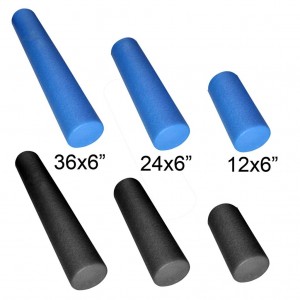Foam rolling is a style of self-myofascial release (SMR) that targets tense and overworked muscles. It’s like myofascial release, a typical technique in massage, otherwise referred to as deep-tissue massage. Masseuses use their hands, elbows or different tools to press directly on a tight muscle till it releases its tension. With the pressure created by your own weight, you’ll use a foam roller on the back, hips, legs, arms and different parts of the body, to release muscle knots. It also can be used to increase balance and core stability. Foam rollers vary in size, shape, foam type and price. By determining your specific uses for the foam roller and what your primary goals are, you’ll purchase a foam roller that matches your needs. This article can tell you how to choose a foam roller that is correct for you.
Try out various foam rollers at a sports supply store or local gym. Most people learn to do foam rolling through a class or a personal trainer. These classes introduce techniques that can help you make the most of your foam roller and give you exercises to use with your roller.
Determine if you will use your foam roller primarily for tissue massage or if its dominant use will be for exercises like balance and core training. Although it is not completely round and only rolls slightly, a half-round foam roller can increase your balance when you stand on it. It is often used by physical therapists to enhance proprioception after injury to knees or ankles. Proprioception is your body’s sense of its parts in relation to each other.
Half-round foam rollers are also a good choice for an elderly person or someone with little strength or muscle tone. When laid with the flat side down, the roller will not move easily out from under them. Simply laying upon a half-round roller in the area of tight muscles can release tension. The user can also move back and forth slightly as they grow comfortable with the roller.

Choose your firmness. A decision of firmness should be based upon your experience-level with the foam roller. Most foam rollers are color coded according to firmness. White rollers are the softest, followed by blue or green rollers of medium density and black foam rollers, which are the firmest.
Choose a white foam roller if you are just starting off with a foam roller or if you plan to use it for exercises. White foam rollers are often made of a piece of polyethylene foam and they are the least dense, so they will allow some movement between the muscles, bones and the roller. Foam rolling can be painful at the beginning because tight muscles are pushed upon with your full body weight. A white foam roller will produce less pressure and less pain.
Choose a medium, lightly colored foam roller for advanced core-stabilization or a medium amount of massage pressure. These blue or green foam rollers are often made of closed cell polyethelene foam or EVA foam and they are common in Pilates classes.
Choose a black foam roller if you are very experienced using a foam roller or desire hard pressure for self-massage. Although most black foam rollers are also made of polyethelene foam, they are closed cell and manufactured under high heat, making them smoother, denser and less porous.
Decide how often you will use the foam roller. For heavy use, it is recommended that you use a denser, black foam roller or EVA foam roller because they are highly durable. White and colored foam rollers made of polyethylene foam can warp over time in humidity and with repeated use. If you desire a softer foam roller, be sure to choose a brand that guarantees it will not warp.
Choose your foam roller size. With the exception of half-round foam rollers, most foam rollers have a 6 inch (15 cm) diameter. However, the length of the foam roller differs greatly, ranging from 12 to 36 inches (30 to 90 cm).
Pick a 36 inch (90 cm) foam roller if you intend to use it on your back. A long foam roller will allow you to roll with it perpendicular to your back, without fear of falling off the ends. It can also be used to create proper alignment by laying on it with the roller parallel to your spine, giving it full support.
Select a 12 inch (30 cm) round roller if you intend to transport your roller often. For example, you may want to bring it to a Pilates class and use it at home.
Identify your budget. The cost of foam rollers depends upon the materials used.
A 12 inch (30) white foam roller will likely be the least expensive, costing under $15. White foam rollers cost less because of the lower density of the foam.
A black foam roller of any size is considered a professional-grade roller and would likely cost around $30.
EVA foam rollers are becoming more popular. They are often green in color. They are moderately firm and offer a more comfortable surface that is warm to the touch. They are advertised as being more durable than polyethylene foam rollers but will likely cost up to $45.
Ultimately, there are a wide variety of foam rollers on the market and choosing the one that works best for you may happen through trial and error. However, as stated earlier, if you are new to foam rolling it is best to start with a less dense (white) roller and work your way up to a more dense (black) roller. Incorporating this into your daily routine will make a tremendous difference in recovery time after a workout as well as help in reducing generalized pain within the body.










